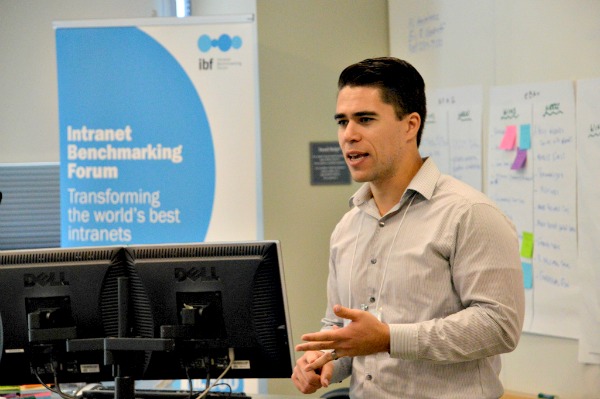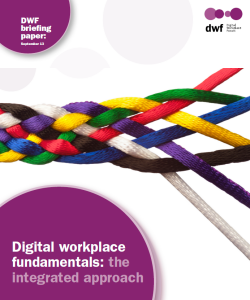Should the intranet team manage the digital workplace?
Successful intranet teams have the unique set of skills needed to manage emerging digital workplace programs. Chris Tubb explains exactly why.
“Ah Intranet team, thanks for coming up here” says the bigwig. “No problem CEO”, you say confidently.
he head honcho continues, “I’ve been thinking about all the digital tools that we use in the company, and let’s face it – it’s all a bit messy. Can you help?”

“No problem CEO”, you say confidently.
It’s a fantasy for sure, but what would you do? Would your mouth go dry and your palms sweat? Would you burble something incomprehensible while looking at your shoes? Or would you stiffen the sinews, open your mouth and let something useful out. What’s your “plan A” intranet guy?
It’s not that I think this scenario is very likely to happen but it isn’t impossible. Perhaps not with the CEO – but how about the COO, the CTO or the CIO? I would like to persuade the intranet world, and to some extent the emerging digital workplace crowd, that the skills we need to start managing all of the morass of digital tools at the disposal of a large multinational are those that the intranet guys have been using for the past 15 or so years.
Stakeholder management
Intranet teams deal with lots of different interests and have to reconcile these into a single experience. Resolving conflicting interests and helping stakeholders see that they are part of the larger whole is second nature to intranet managers. Using the same approach to make individual system owners actively want to be part of a more coherent digital workplace, although a markedly more difficult job, should be an achievable stretch.
See our report on how cross-functional digital workplace teams are a key to success.
Standards, controls and governance
Intranet teams create and maintain systems of governance to ensure that everyone concerned knows what the rules are and, even if they disagree with them, are able to air their disagreements in a formal way. Extending the array of expectations, steering forums and management oversight? Definitely do-able.
Managing complexity, providing structure and coherence
Intranet teams are forever cramming a reservoir into a pint pot. People, places, things, content and applications are organised in ways that hopefully connect the right asset to the right person at the right time. The intranet is adept at absorbing the breaking waves of new technological demands. For the wider digital workplace I am convinced there should be a group that understands the demands of such a structure, understands its value and can communicate this. And I know just the team…
Representing the user
The successful intranet team not only thinks of the user during development, but represents the needs of the user to the bureaucracy via the governance model. Extending these systems of empathy beyond the boundaries of the web browser? Consider it done.
Balancing technology with purpose
Many intranet managers consider themselves “technology interpreters”. They understand enough about technology to talk with the IT team and also understand the business perspective well enough to converse with executives. Most critically, though, they have the communication skills to translate between the two.
Because of this unique position intranet managers can put the intranet’s purpose and users’ needs first. They avoid the mistake of becoming enslaved by the technology and instead bend the technological tools around clear goals.
The elevator pitch
So your mouth is dry and your palms are sweaty. Your lips begin to speak:
“It strikes me that, yes, our systems have become complex. Things have changed very quickly recently with capabilities to access things using phones and tablets, and lots of new ways of collaborating together. At the same time people are relying on their digital tools like never before to get their jobs done, and even as they are getting good at using them they find it frustrating. Because each of these systems were put in separately by different teams, without truly considering the needs of the employees, they all work differently. What we try and do on the intranet is make sure that the employees’ needs are catered for by knowing all our different sorts of users and having the governance in place to ensure that we provide a good experience, no matter who owns the many systems we provide access to. We also concentrate on providing employees with ways to find the information and tools they need to work with quickly. At the same time we make sure that the company’s requirements for security, regulation and risk are dealt with. So we are not only trying to make the intranet good enough to use, we are trying to infuse it with our values. This isn’t just technology anymore – it is part of our culture and brand. Do you think that applying those approaches to all of our systems, intranet or not, might be a useful approach?”
Maintain eye contact throughout.
Related research
Digital workplace fundamentals – an integrated approach
 This report suggests a blueprint for launching a successful digital workplace initiative anchored on two key prerequisites, namely scope (what is included) and approach (how it is delivered).
This report suggests a blueprint for launching a successful digital workplace initiative anchored on two key prerequisites, namely scope (what is included) and approach (how it is delivered).
Among the key takeaways highlighted in this report are 1) the digital workplace permeates all aspects of working life, 2) it affects technology, physical workplaces and people, and 3) cross-functional teams increase the chances of a project successfully meeting its outcomes.
Categorised in: Digital workplace, Strategy & governance
